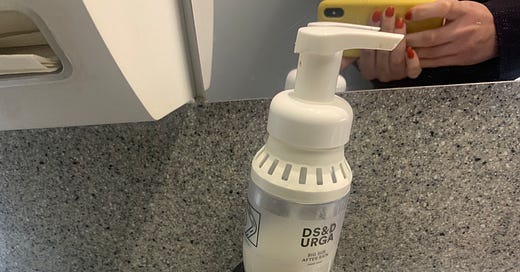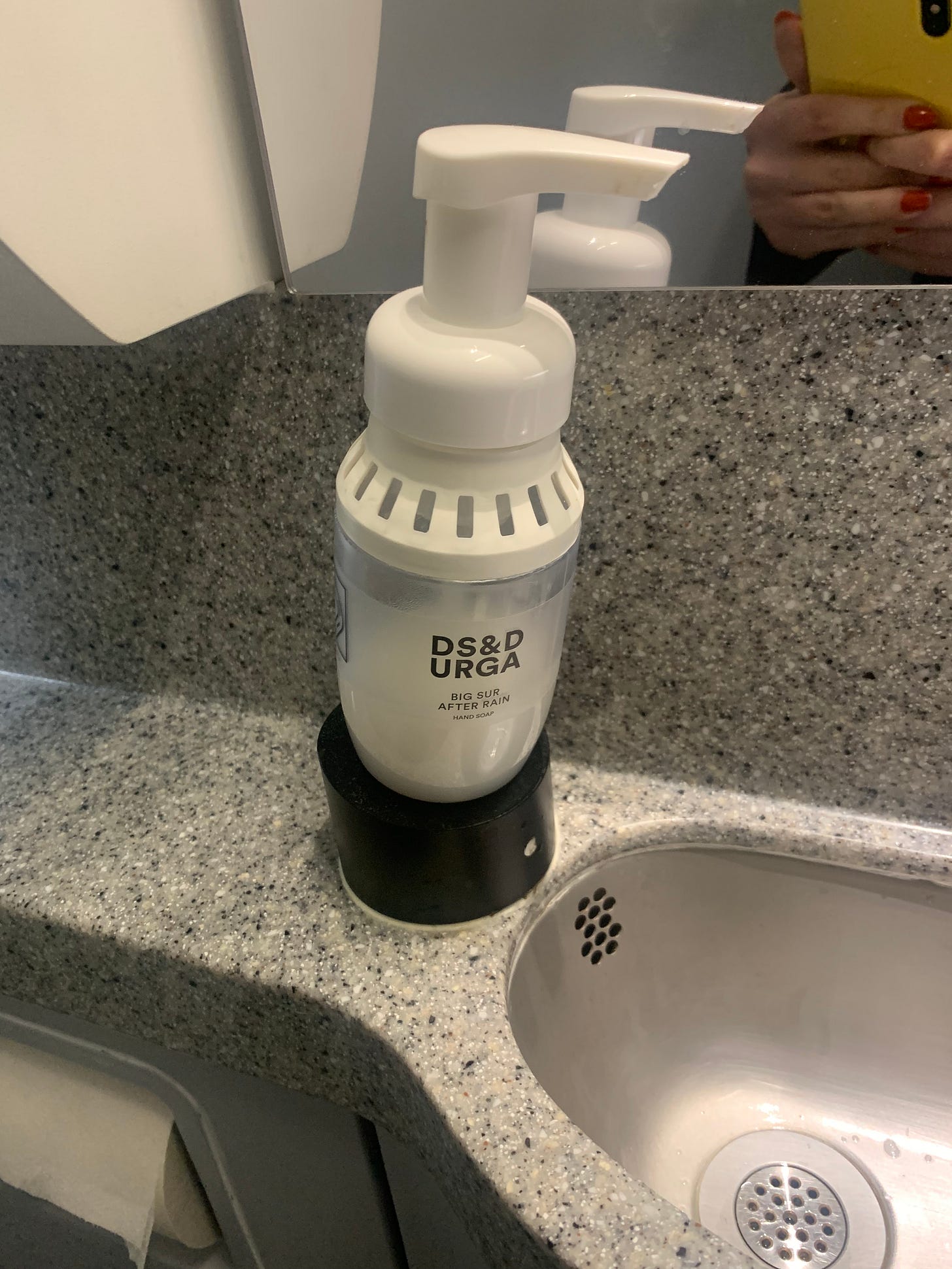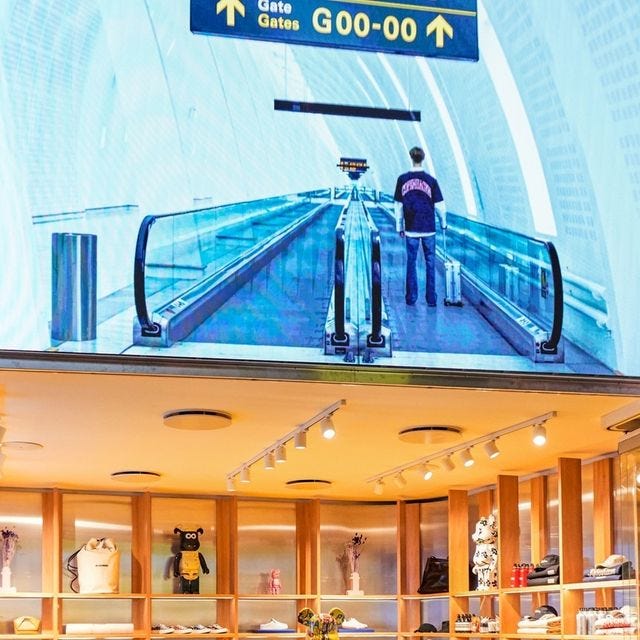A friend and former colleague is such a germaphobe that as I took this photo I thought, she would probably be horrified to learn I brought my phone into an airplane bathroom (if you’re reading this, you know who you are, and I’m sorry for subjecting you to this image). But I’m a garbage person and I’m not afraid to touch things on the plane. And so on my return flight to New York from seeing my family in California, I purposefully took my phone into the grimey hollow of the airplane bathroom for journalism, a.k.a. so I could snap a photo of this D.S. & Durga Big Sur After Rain hand soap. And of course, I washed my hands thouroughly afterwards.
Flying is full of increasing indignities, such that any small comfort that hasn’t been nickel and dimed out of you can feel like a sip of nectar beamed down from god. And I actually like flying! Probably significantly more than the average person. Maybe that’s just a Stockholm syndrome response to the necessity of folding myself up like a taco into a pleather seat in exchange for the privilege of being shuttled across the sky. But you look for small pleasures where you can get them, and so I was intrigued to see a hand soap from a cool Brooklyn-based fragrance brand in the coach section of an American Airlines bathroom. This isn’t the generic pink soap or antibacterial Dial that I’d expect to see on an airplane; it doesn’t just smell nice, outside the airplane and in the real world, the Big Sur After Rain hand soap sells for $55 a bottle.
This was news to me, but apparently D.S. & Durga has had a partnership with American Airlines since 2021, providing first, business and premium economy passengers with a dopp kit including lotion and lip balm from the brand. Qatar Airways has a similar partnership with Diptyque, as does Emirates with Bulgari’s beauty line. But those are airlines with a reputation for luxury partnering with massive luxury brands (Diptyque is owned by private equity firm Manzanita Capital and has something in the range of 100 stores globally, while Bulgari is, well, Bulgari, a crown jewel in the LVMH portfolio).
American Airlines is, meanwhile, something I fly because I have to. And D.S. & Durga is the kind of indie-ish name you only know if you’re following fragrance trends beyond the department store counter. The brand has three stores in New York and one in Los Angeles, with perfumes like figgy Debaser and the iso e super-based I Don’t Know What hitting that sweet spot of trendy but not oversaturated. Their hand soaps aren’t exactly status hand soaps on par with Aesop or Le Labo, but let’s put it this way: if you can clock an Aesop Resurrection hand soap bottle from ten paces, you probably at least know of D.S. & Durga.
But that may be changing soon enough. A source once commented to me, “They’re everywhere aren’t they?” after sharing yet another perfume trend piece where D.S. & Durga founder and perfumer David Seth Moltz is quoted. And I’ve quoted Moltz in a number of pieces too; intentionally or not, his launches hit on trends as they’re happening and he’s adept at articulating how and why fragrance connects to larger cultural shifts. It helps too that you can talk to him as an actual human rather than jumping through multiple PR hoops to get a watered-down quote. The brand is familiar with collabs, having partnered with the likes of Todd Snyder and The Carlyle. You know, fancy stuff. So I wouldn’t have thought the antiseptic spittoon of an American Airlines bathroom would be where they’d want to display their product. But then where else can you get a captive audience like bedraggled air travelers?
I sometimes describe perfumes as smelling like an airport duty-free. Which is another way of saying “generic” (which is not the same as bad). I actually love perusing an airport duty-free and spraying all the perfumes, but this isn’t where you go to be challenged or discover new ideas. This is where you find the latest Marc Jacobs Daisy flanker and your Paco Rabanne 1 Million. Unlike something like Debaser, these have celebrity spokespeople and accessible prices (by perfume standards) to draw you in. Even with countless new launches and flankers, they always kind of smell the same, with slight variations on floriental1 blends and dihydromyrcenol2.
But who’s to say airport smells need to stay in the lowest common denominator? In 2021, Berlin-based streetwear connoisseur Highsnobiety launched Gatezero, a concept store for the Zurich airport and later Copenhagen (full disclosure and self-plug, I worked on some online features for this project). The store stocks, along with JW Anderson bags and On sneakers, perfume and skincare from brands like Byredo, Aesop, Comme des Garçons, all massive names in the left-of-designer fragrance space. And perhaps more surprisingly, the store also carries smaller fragrance brands like French natural perfume line Ormaie and Swedish hippie-inspired brand 19-69.
Part of the appeal of niche brands is that they’re harder to come by than their designer counterparts. You get a niche perfume cause you don’t want the same Dior Homme and Coco Mademoiselle that everyone else has. Or at least that used to be the case — niche fragrance has mainstream appeal now. Byredo, which began as a true niche brand in 2006, is now owned in part by fragrance giant Puig and has hundreds of stores and counters worldwide. TikTok has created an appetite for weird and challenging scents, with viral popularity in arms reach for even the most indie brands. The trappings of the niche aesthetic, like unisex marketing and offbeat names, can be found at Sephoras across the country.
And apparently niche fragrance has enough appeal that American Airlines thinks you’d like notes of damp eucalyptus leaves with your courtesy pretzels and ginger ale. I certainly do anyway. There are some fragheads who believe Byredo’s selling up and out means their scents have gotten less interesting. And that may be true, but if niche perfume brands can add a little extra sensorial pleasure to the horror of air travel, then I’ll take it.
yes, “floriental” is a real perfume term. It’s a category that blends floral notes with spices and ambers, the latter of which are often called “oriental” though that term is falling out of favor for obvious reasons. Viktor & Rolf Flowerbomb is a floriental.
dihydromyrcenol is a fragrance compound that makes men’s cologne smell like men’s cologne. It’s that brisk, barbershop, blue-green smell that is characteristic of Bleu de Chanel and Dior Sauvage. It’s also, along with coumarin, key to most Axe fragrances.





